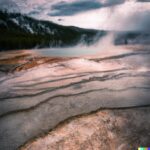Yellowstone National Park is home to some of the most stunning geysers in the world, but it’s not just the natural beauty that attracts attention. The geysers are also home to a diverse array of bacteria that have adapted to thrive in extreme environments.
From thermophiles to acidophiles, these resilient microorganisms have unique characteristics that allow them to survive in harsh conditions. In this article, we will explore the types of bacteria found in Yellowstone geysers, their characteristics, ecological roles, and how scientists study them. Get ready to be amazed by the hidden world of bacteria in Yellowstone geysers!
What Are Bacteria in Yellowstone Geysers?
Bacteria in Yellowstone geysers are a diverse group of extremophiles that thrive in the hydrothermal environments characterized by high temperatures and unique chemical compositions.
What Are the Types of Bacteria Found in Yellowstone Geysers?
The types of bacteria found in Yellowstone geysers encompass a spectrum of extremophiles, including thermophiles, acidophiles, alkaliphiles, and halophiles, each uniquely adapted to the harsh geothermal conditions.
Thermophiles
Thermophiles in Yellowstone geysers represent a prominent group of heat-loving microorganisms that thrive in the extreme temperatures of the hydrothermal features, contributing to the diverse microbial communities within the hot springs and microbial mats.
Their remarkable ability to withstand high temperatures, some exceeding 70°C, is attributed to their unique biological and biochemical adaptations, such as specialized enzymes and membrane structures.
These extremophiles play a critical role in the formation of microbial mats, which are complex, multilayered ecosystems that provide habitats for various microorganisms. The microbial mats also contribute to the overall microbial diversity in hot spring ecosystems, showcasing the significance of thermophiles in these extreme environments.
Acidophiles
The acidophiles found in Yellowstone geysers are specialized microbial organisms capable of thriving in acidic geothermal environments, exhibiting unique adaptations to the extreme pH conditions and demonstrating thermotolerance in their ecological niche.
Thermophilic microorganisms have evolved impressive mechanisms to survive in harsh conditions. They can maintain intracellular pH balance, resist metal toxicity, and form biofilms for protection. Their ability to tolerate high temperatures allows them to thrive in Yellowstone’s geothermal features, where they play a crucial role in nutrient cycling and primary production.
These acidophilic microorganisms also contribute to the ecological stability and diversity of these extreme environments. Their resilience showcases the remarkable adaptability of thermophilic microbes in Earth’s harshest habitats.
Alkaliphiles
The alkaliphiles thriving in Yellowstone geysers are a remarkable group of thermophilic extremophiles adapted to the high pH conditions of the geothermal waters, contributing to the microbial diversity within the hot water environments.
Their resilience in withstanding extreme conditions and their ability to thrive at temperatures exceeding 65°C make them crucial players in the biogeochemical cycles of these unique ecosystems.
These alkaliphiles play a vital role in the conversion of organic matter and sulfur compounds, contributing significantly to the overall stability and functionality of the Yellowstone hot water habitats.
Their specialized enzymes enable them to metabolize under such extreme conditions, making them of great interest to researchers studying extremophiles and their potential applications in biotechnology and industrial processes.
Halophiles
Halophiles found in Yellowstone geysers are extremophilic microorganisms capable of thriving in the saline conditions of hydrothermal vents, showcasing their unique adaptations to the high-temperature saline environments and contributing to the bacterial diversity in these habitats.
Their ability to withstand high salinity levels and extreme temperatures allows them to thrive in what are otherwise inhospitable conditions for many other forms of life.
These halophiles play a crucial role in the microbial communities of Yellowstone geysers, where they contribute to the overall ecological balance and unique ecosystem of these hydrothermal environments.
Their presence underscores the remarkable diversity of life that exists in these extreme settings and offers valuable insights into the adaptation strategies of microorganisms in such habitats.
What Are the Characteristics of Bacteria in Yellowstone Geysers?
The characteristics of bacteria in Yellowstone geysers encompass remarkable adaptations to extreme temperatures, the ability to survive in harsh environments, and the presence of unique metabolic pathways, reflecting the diversity and resilience of the microbial life thriving in these geothermal features.
Adaptations to Extreme Temperatures
The bacterial communities in Yellowstone geysers exhibit remarkable adaptations to extreme temperatures, showcasing thermophilic and thermotolerant characteristics that enable their survival and proliferation within the geothermal environments.
Extremophilic bacteria possess unique biological mechanisms that enable them to survive in extreme environments, with temperatures ranging from 90°C to 0°C. Their thermophilic nature allows for efficient enzymatic reactions at high temperatures, while their thermotolerance helps them withstand thermal fluctuations.
These adaptations are essential for their ecological significance, as they play a crucial role in nutrient cycling and maintaining ecosystem stability in extreme environments. Furthermore, their ability to thrive in these harsh conditions provides valuable insights for biotechnological applications, such as industrial processes and the development of heat-resistant enzymes.
Ability to Survive in Harsh Environments
Bacteria in Yellowstone geysers demonstrate the remarkable ability to thrive and persist in harsh geothermal environments, highlighting the resilience and adaptability of extremophile bacteria and extremophilic microorganisms within the hydrothermal vents.
Extremophilic bacteria have evolved unique mechanisms to survive in extreme conditions, such as high temperatures, acidic pH levels, and high pressure. This makes them some of the most resilient organisms on Earth.
These extremophiles have also developed specialized metabolic pathways to utilize diverse energy sources, including sulfur, iron, and hydrogen. These elements are abundant in the volcanic ecosystems of Yellowstone. Their remarkable adaptability and ecological resilience demonstrate the incredible diversity and adaptability of extremophilic bacteria in extreme environments. This also provides valuable insights into the potential for life in other extreme habitats beyond Earth.
Unique Metabolic Pathways
The bacterial communities in Yellowstone geysers boast unique metabolic pathways demonstrated by thermophilic bacteria and prokaryotes, contributing to the diverse biochemical processes and ecological functions within the geothermal habitats.
Thermophilic bacteria and prokaryotes have evolved unique mechanisms to survive in Yellowstone’s extreme geysers. They use specialized enzymes and metabolic pathways, like sulfur oxidation and carbon fixation, to obtain energy and nutrients from the geothermal features. This biochemical diversity not only enables them to withstand high temperatures and acidic environments but also plays a vital role in shaping the overall microbial ecology of the geysers. These thermophilic prokaryotes also contribute to biogeochemical cycles in these exceptional habitats, highlighting their ecological significance.
How Do Bacteria Survive in Yellowstone Geysers?
Bacteria in Yellowstone geysers employ various survival strategies, including protection from UV radiation, utilization of sulfur compounds, and the formation of biofilms, enabling their adaptation and persistence in the extreme geothermal conditions.
Protection from UV Radiation
Extremophilic bacteria in Yellowstone geysers have developed mechanisms to protect themselves from UV radiation and thermal stress, allowing them to thrive in the intense solar exposure and high-temperature conditions of the hot springs.
These remarkable adaptations include the production of pigments that shield their DNA from UV damage, as well as efficient DNA repair mechanisms to counteract radiation-induced mutations.
Many thermophiles in hot springs utilize specialized enzymes and heat shock proteins to maintain their cellular structures and functions at elevated temperatures, thereby enhancing their ecological resilience in these extreme environments.
The ability of extremophilic bacteria to withstand such harsh conditions not only reveals their remarkable survival strategies but also sheds light on the potential applications of their unique biochemistry in diverse fields, such as biotechnology and astrobiology.
Utilizing Sulfur Compounds
Bacteria in Yellowstone geysers utilize sulfur compounds as an energy source, demonstrating unique metabolic pathways and ecological adaptations within the hydrothermal vents, contributing to their survival and the microbial ecology of the geothermal habitats.
These extremophilic bacteria have evolved intricate enzymatic systems to harness the energy from sulfur compounds in these extreme conditions. Their metabolic versatility enables them to thrive in the high-temperature, acidic, and sulfurous environments, where other organisms struggle to survive.
This ecological niche provides essential insights into the interconnected web of microbial interactions and the biogeochemical cycling of sulfur, shaping the hydrothermal vent ecosystems and influencing the overall microbial diversity and resilience in the geothermal regions.
Forming Biofilms
The formation of biofilms by extremophilic bacteria in Yellowstone geysers facilitates their resilience and persistence, contributing to the stability and structure of microbial mats and enhancing their ecological impact within the geothermal environments.
Extremophilic bacteria, known as thermophiles, thrive in the extreme temperatures and unique chemical compositions of the geysers. Their ability to form biofilms is a key factor in stabilizing microbial mats, creating a strong network that supports diverse microbial life.
This process plays a crucial role in shaping the microbial ecology of the geysers and influencing nutrient cycling, energy flow, and overall ecosystem dynamics. The extremophile biofilms also provide protection and support to other microorganisms, allowing for a rich and diverse microbial community to flourish in these extreme conditions.
What Are the Ecological Roles of Bacteria in Yellowstone Geysers?
Bacteria in Yellowstone geysers play crucial ecological roles as primary producers, facilitators of nutrient cycling, and participants in symbiotic relationships, shaping the complex microbial communities and ecological dynamics within the geothermal habitats.
Primary Producers
Bacteria in Yellowstone geysers serve as primary producers, utilizing unique metabolic pathways and harnessing geothermal energy to initiate the food web. This sustains the diverse ecosystem of thermophilic microorganisms within the geothermal environments.
The extremophilic bacteria found in the geysers are able to survive and thrive in extreme conditions. They play a crucial role in the energy flow of this ecosystem.
Through chemosynthesis, these bacteria are able to convert inorganic compounds into organic matter, providing the energy foundation for the entire food chain. This not only supports the sustainability of thermophilic microorganisms, but also contributes significantly to the overall primary productivity of the Yellowstone geysers.
Without these resilient bacteria, the entire ecosystem’s energy dynamics would be compromised.
Nutrient Cycling
Bacteria in Yellowstone geysers actively participate in nutrient cycling, facilitating the recycling and redistribution of essential elements. This process influences the microbial diversity and ecological dynamics within the geothermal habitats.
Geysers are known for their extreme conditions, and thermophiles are essential for sustaining them. These extremophiles have adapted to the high temperatures and contribute significantly to the microbial diversity in geysers. As a result, they play a crucial role in shaping the ecological dynamics of these unique ecosystems.
The metabolic activities of these extremophiles, such as sulfur oxidation and carbon fixation, are vital for nutrient cycling. This process helps maintain the delicate balance of geothermal communities, making it possible for these extreme environments to thrive.
Symbiotic Relationships
Bacteria in Yellowstone geysers engage in symbiotic relationships with other microorganisms, contributing to the stability and ecological balance of extremophilic and thermophilic communities. This shapes the intricate web of interactions within the geothermal ecosystems.
Extremophilic bacteria are essential for the survival of thermophilic organisms in extreme heat and acidic conditions. They play a crucial role in nutrient and energy cycling, supporting diverse microbial communities through biofilm formations and metabolic partnerships. These interactions contribute to the unique and dynamic nature of Yellowstone’s geothermal ecosystems, highlighting the significance of extremophiles in maintaining the delicate ecological balance of the region.
How Do Scientists Study Bacteria in Yellowstone Geysers?
Scientists employ various methodologies, including sample collection, DNA sequencing, and microscopy, to study the diverse bacterial communities thriving in the extreme geothermal environments of Yellowstone geysers, unraveling the complexities of microbial life and ecological dynamics.
Sample Collection
Scientists conduct extensive sample collection in Yellowstone geysers to gather microbial specimens and environmental data, providing valuable insights into the distribution and genetic diversity of extremophilic and thermophilic microorganisms within the geothermal ecosystems.
This meticulous sampling process enables researchers to characterize microbial diversity and ecological patterns, shedding light on a wide range of biological activities in extreme environments. By analyzing these samples, scientists can unravel the adaptations and survival strategies of these bacteria, offering crucial knowledge for biotechnology and astrobiology research.
The collected data aids in understanding the intricate relationships between microorganisms and their surroundings, contributing to the broader understanding of geothermal systems and their potential applications in various industries.
DNA Sequencing
DNA sequencing techniques enable scientists to unravel the genetic composition and diversity of bacterial communities in Yellowstone geysers, providing critical insights into the evolutionary relationships and ecological functions of extremophilic microorganisms within the geothermal habitats.
By examining the genetic makeup of these bacterial communities, researchers can gain a deeper understanding of how these extremophiles have adapted to the extreme conditions of Yellowstone’s geysers.
DNA sequencing offers a powerful tool to identify specific microbial species, track their distribution in the geothermal features, and examine their roles in biogeochemical cycles. This technology further aids in identifying novel microorganisms with unique metabolic capabilities, enriching our knowledge of microbial ecology and the vast bacterial diversity thriving in Yellowstone’s high-temperature environments.
Microscopy
Microscopy techniques allow scientists to explore the intricate structures and interactions within microbial mats in hot springs, revealing the spatial organization and ecological dynamics of extremophilic and thermophilic microorganisms thriving in the geothermal environments of Yellowstone geysers.
These microscopy methods provide a closer examination of the diverse communities and metabolic processes occurring in these extreme habitats.
By observing the cellular morphology and behavior of extremophiles, researchers gain valuable insights into their adaptation strategies and the roles they play in biogeochemical cycling.
The high-resolution imaging also aids in understanding the spatial distribution of different microbial species and their response to environmental gradients, shedding light on the complex web of interactions that define the ecosystem dynamics in hot springs.
Frequently Asked Questions
What role do bacteria play in Yellowstone geysers?
Bacteria in Yellowstone geysers play a vital role in the geothermal ecosystem by breaking down minerals and creating unique colors and formations.
How many different types of bacteria have been found in Yellowstone geysers?
Scientists have identified over 500 different types of bacteria in Yellowstone geysers, with many more still waiting to be discovered.
Are bacteria in Yellowstone geysers harmful to humans?
While some bacteria found in Yellowstone geysers can be harmful to humans, they are usually only present in small amounts and pose little risk to visitors. It is important to follow all safety guidelines and avoid direct contact with geysers and hot springs.
Do bacteria in Yellowstone geysers have any unique adaptations?
Yes, bacteria in Yellowstone geysers have developed unique adaptations to survive in the extreme conditions, such as high temperatures and acidic environments.
Can bacteria in Yellowstone geysers survive outside of the geothermal ecosystem?
No, bacteria in Yellowstone geysers are specialized to survive in the specific conditions found within geysers and would not be able to survive outside of this environment.
What research is currently being done on bacteria in Yellowstone geysers?
Scientists are continually conducting research on the bacteria found in Yellowstone geysers to better understand their role in the ecosystem and their potential for medical and industrial applications.
Last Updated on January 25, 2024 by Jon Waraas – Originally Posted: January 25, 2024

I’m Jon Waraas, and I’ve been navigating the online world since 2006. By day, I’m the proud owner of some eCommerce gems, and by night, I’m the voice behind the adventures on Waraas.Com.
My heart, however, belongs to the wild beauty of Yellowstone National Park. I’ve got a collection of websites dedicated to sharing the wonders of this natural masterpiece. Oh, and did I mention? I’m currently building my own cabin inside the ghost town of Gilmore, Idaho – a cabin with tales to tell!
When I’m not immersed in the digital realm, you’ll find me lacing up my boots for a good hike or setting up camp under the star-studded sky.




